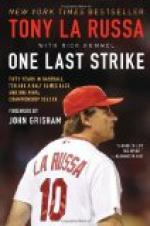“There,” announced Remsen finally, “that’s a lot better. Now kick.” Joel caught the ball nicely, and sent it sailing far down the field.
“That’s a good kick, but it would have been better had you landed higher up on your foot. Try and catch the ball just in front of the arch of the foot. You take it about on the toe-cap. Remember that the broader the surface that propels the ball the greater will be the accuracy—that is, the ball has less chance of sliding off to one side when the striking surface is large. Here’s your ball coming. Now try again, and remember what I have said about the swing at the hip. Forget that you have any joints at all, and just let the right side of you swing round as it will.”
Then Remsen passed on to the next man and Joel pegged away, doing better and better, as he soon discovered, every try, until a whistle blew from the middle of the field and the players gathered about the captains on the fifty-five-yard line. Joel was down to play left half on the second eleven, and beside him, at right, was Wills, a promising lower middle boy, who was an excellent runner, but who, so far, had failed to develop any aptitude for kicking. Cloud and Clausen occupied similar positions on the first eleven, and behind them stood Wesley Blair, the best full-back that Hillton Academy had possessed for many years. The full-back on the second eleven was Ned Post, a veteran player, but “as erratic as a mule,” to use the words of Stephen Remsen.
The first eleven was about six pounds heavier in the line than the team captained by Louis Whipple, who played at quarter, and about the same weight behind the line. It was a foregone conclusion that the first would win, but whether the second would score was a mooted point. Joel felt a bit nervous, now that he was in his first game of consequence, but forgot all about it a moment later when the whistle blew and Greer, the big first eleven center, tore through their line for six yards, followed by Wallace Clausen with the ball. Then there was a delay, for the right half when he tried to arise found that his ankle was strained, and so had to limp off the ground supported by Greer and Barnard, the one-hundred-and-sixty-pound right tackle. Turner, a new player, went on, and the ball was put in play again, this time for a try through left tackle. But the second’s line held like a stone wall, and the runner was forced back with the loss of a yard. Then the first eleven guards fell back, and when the formation hit the second’s line the latter broke like paper, and the first streamed through for a dozen yards. And so it went until the second found itself only a few yards from its goal line. There, with the backs pressed close against the forwards, the second held and secured the ball on downs, only to lose it again by a fumble on the part of Post. Then a delayed pass gained two yards for the first and a mass at left tackle found another. But the next play resulted disastrously, for when the ball was passed back there was no one to take it, and the quarter was borne back several yards before his own astounded players could come to his assistance.




